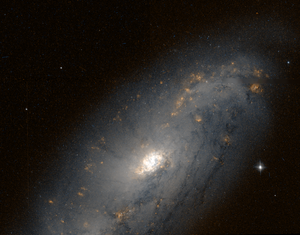NGC 1808
| Galaxy NGC 1808 |
|
|---|---|

|
|
| Photo from the Hubble Space Telescope | |
| AladinLite | |
| Constellation | Dove |
|
Position equinox : J2000.0 , epoch : J2000.0 |
|
| Right ascension | 05 h 07 m 42.3 s |
| declination | -37 ° 30 ′ 47 ″ |
| Appearance | |
| Morphological type | (R'_1) SAB (s:) b Sy2 |
| Brightness (visual) | 9.9 likes |
| Brightness (B-band) | 10.8 mag |
| Angular expansion | 6.5 ′ × 3.9 ′ |
| Position angle | 133 ° |
| Surface brightness | 13.3 mag / arcmin² |
| Physical data | |
| Affiliation | NGC-1808 group, LGG 127 |
| Redshift | +0.003319 +/- 0.000013 |
| Radial velocity | +995 ± 4 km / s |
|
Stroke distance v rad / H 0 |
(37 ± 3) x 10 6 ly (11.3 ± 0.8) Mpc |
| diameter | 35,000 ly |
| history | |
| discovery | James Dunlop |
| Discovery date | May 10, 1826 |
| Catalog names | |
| NGC 1808 • PGC 16779 • ESO 305-008 • MCG -06-12-05 • IRAS 05059-3734 • 2MASX J05074234-3730469 • SGC 050559-3734.6 • GC 1021 • h 2740 • AM 0505-373 • Dun 549 • LDCE 0384 NED002 | |
NGC 1808 is a barred spiral galaxy in the constellation Dove , about 37 million light years from the Milky Way . NGC 1808 is a starburst galaxy with violent star formation in its central region.
The object was discovered on May 10, 1826 by the Scottish astronomer James Dunlop .

The center of NGC in 1808 captured by the Hubble Space Telescope
Individual evidence
Web links
- NGC 1808: A Nearby Starburst Galaxy - Astronomy Picture of the Day, July 1, 1998.
- Starbirth in NGC 1808 - Astronomy Picture of the Day of March 23, 1998 (English).
- The Starburst Galaxy 1808
- HST imaging of the startburst galaxy 1808
